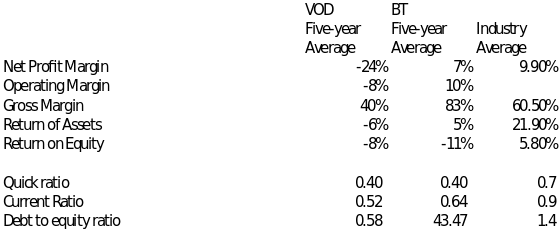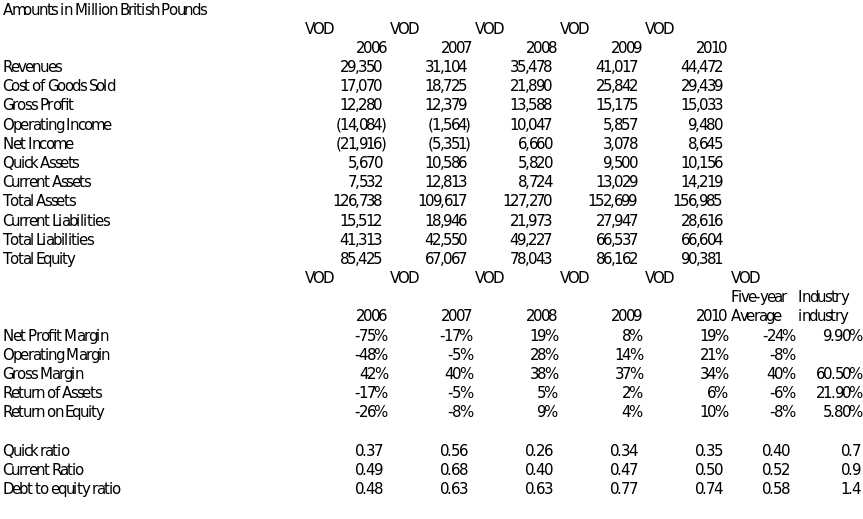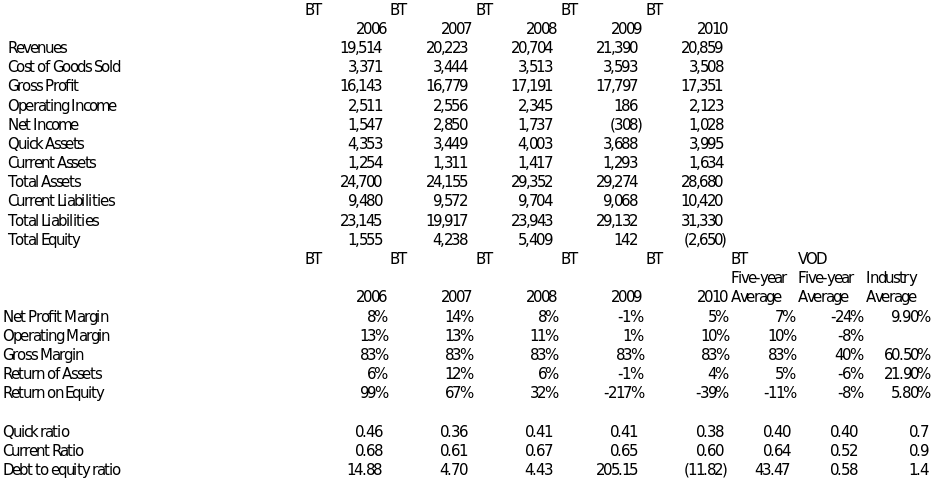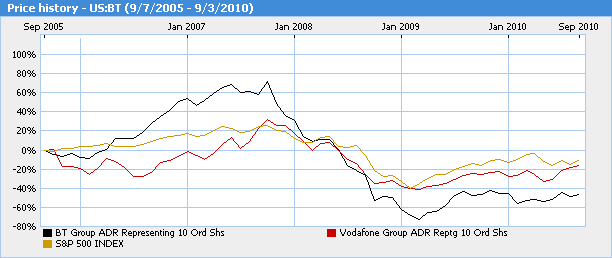Introduction
This paper has chosen Vodafone plc (or “Vodafone”) and British Telecom plc (or “BT”) under the telecommunications industry for purposes of comparing capital structure and cost of capital. This will also study the impact of industry and economic conditions for the pair of companies and will explore the current circumstances of both companies and their industry in the context of broader economic development.
Analysis
Investigate the capital structure of the two companies as it emerges in their reported financial statements. Identify similarities, differences, and other possible explanations. Explore and describe changes over the recent years but also focus on the discussion and explanation of your findings. Your investigation can be extended back to five or ten years.
To study the capital structure of the two companies’, there is a need to compare their debt to equity ratios. Generally, the lower the debt to equity ratio the better or more favourable it is for a company since it would mean less risk. As found out, Vodafone is less financially leveraged than BT plc because of the lower debt to equity ratio of the former than the latter. Their debt to equity ratio is affected by their liquidity and profitability.
This means that Vodafone’s less risky position may have been cause by some internal and external factors. Internal factors for the purpose of this paper will focus on profitability and liquidity. External factors may refer to business and economic conditions (Samuelson, and Nordhaus, 1992; Slavin, 1996) that are affecting both companies. Since the two companies belong to the same telecommunications industry, discussion of what happened to their capital structure would be looked more deeply in terms of internal factors.
Good capital structure may be viewed in terms of solvency or for the company’s long-term capacity to keep up it stability over the long term. Normally measured by the debt to equity ratio, with the formula of having the total debt of the company divided by its total equity; a company’s solvency ratio should guide investors whether the company can exist both in the short and long term to recover long term investments which may take years. The debt to equity ratios of Vodafone are 0.48, 0.63, 0.63, 0.77 and 0.74 for the years 2006, 2007, 2008, 2009 and 2010 respectively or an average of 0.58. BT on the other hand had 14.88, 4.70, 4.43, 205.15 and (11.82) for the years 2006, 2007, 2008, 2009 and 2010 respectively or an average of 43.47. Vodafone is evidently more favourably leveraged than BT since the former is below industry average of 1.4 while the latter is at least thirty times riskier than industry average.
Vodafone ratios are still very low since not a single year ratio has reached 1.0. This means that the company’s amount investment from stockholders had been matched by what it borrowed or that there had been fewer amounts of debts in relation to equity. BT on the other hand was evidently higher leveraged than Vodafone with every single year’s debt to equity ratio exceeding 1.0. The year 2009 showed more than 200.0 debt to equity and this got worse in 2010 with negative ratio of (11.82), which indicated already a deficit.
In examining the changes in the Vodafone ratios, it could be asserted an a marked improvement was noted from 2009 to 2010 and that in some years the annual ratio could had deteriorated. However not reaching 1.0 is still a good sign of capital structure, which indicates that a viable capital structure was maintained, and what may have kept the same may be explained by the results of variable level of profitability particularly in the last two years for Vodafone. BT on the other hand may have improved from 2006 to 2007 and then to 2008 but it tremendously suffered in 2009 and 2010 because of negative or poor profitability.
Capital Structure, Profitability and Efficiency
Vodafone may be less profitable than BT based on the annual average for the last five years. However, by focusing on the years 2009 and 2010, Vodafone was more profitable than BT. While Vodafone has shown increasing revenues for the years 2009 and 2010; BT exhibited slight increase only in 2009 and suffered a decline in 2010. Coupled with the decreasing revenues of BT, the company actually has reflected negative return on equity for both years while Vodafone has shown positive return on equity (ROE) of 4% and 10% for the years 2009 and 2010 respectively. The negative ROE for BT reached a very high level of (217%) for 2009 and (39%) for 2010. See Table 1 below in relation to Appendices A and B. Such sudden decline in profitability has resulted into deficit resulting to a negative amount of stockholder equity. These have in effect produced negative debt to equity ratios for the years 2009 and 2010.

The return on equity of Vodafone indicated different meanings about the past performance of the company in the past five years with the earlier years as unprofitable but with a turnaround starting in 2008. The ROE’s from 2006 to 2007 were actually dismal with negative rates but 2008 positive ROE and onwards appeared to be good sign of resiliency as the recession might have caused its ugly effects then in terms of lower demand. From 9% in 2008, it has decreased to 4% in 2009 and but rebounded again in 2010. See Table above one in relation to Appendices A and B.
The range of 4% to 10% return on equity would mean that for every £100 GBP investment, the investors expect returns of about 4 to 10 Pounds Sterling and this must very encouraging to investors in times of recession.
It may be noted that return on equity used the formula has net profits divided by the total stockholders’ equity (Bernstein, 1993; Meigs, Meigs and Meigs, 1995). When compared to a Bank of England base rate of 0.50% (Housepricecrash, 2010), which can be an estimate of rate return from a money that is invested in a risk free rate investment like a treasury bill, Vodafone’s ROE is still very high. This makes a finding of ROE far more than 8 times the risk free rate at the minimum and 20 times at the maximum; hence it should be an investment that is very difficult to find and very attractive to investors.
BT in comparison reflected negative rate of (11%) as average for the past five years would mean that the company had been losing money.
Closely related with profitability of the two companies is their efficiency. An efficient company is generally more profitable than an inefficient one. This can be measured in terms of net operating margin and net profit margin.
Vodafone’s operating profit margins for the last five years were reflected at -48%, -5%, 28%, 14% and 21% for the years 2006, 2007, 2008, 2009 and 2010 respectively or an average of 11% as against BT’s 13% 13% 11% 1% 10% for the same years respectively or an average of 10%. On the average, Vodafone is more efficient. On the other hand, net profit margins of Vodafone for the last five years registered -75% -17% 19% 8% 19% for the years 2006, 2007, 2008, 2009 and 2010 respectively or an average of (-46%) appears lower than BT’s 8% 14% 8% -1% 5% for the same years respectively or an average of 7%. The better efficiency of Vodafone is however is evident in the last three years. See Appendix A and B.
Operating margin represents the margin after deducting cost of sales or services and operating expenses. Things to be added or deducted still are other income(s). The ratios mean that the management of Vodafone is doing better than BT s with the participation of employees in delivering value to customers; therefore, it can be safely inferred that the company is both more profitable and operating efficiently which contributed to its having a better capital structure as of 2010.
Capital Structure and Liquidity
Liquidity ratio is needed for company as way to know whether it is able to meet a company’s currently maturing obligations. It is normally measured using the current ratio and the quick asset ratio. As applied now, the current ratios of Vodafone are 0.49, 0.68, 0.40, 0.47 and 0.50 for the years 2006, 2007, 2008, 2009 and 2010 respectively or an average of 0.52. On the other hand, its quick asset ratios for same years are 0.49, 0.68, 0.40, 0.47 and 0.25 for the same years respectively or an average of 0.40. See Table 1 above in relation to Appendices A and B.
It must be noted that both ratios have shown fluctuating trends for the years covered, but on the overall, both have increased compared to 2006 level lower still than industry averages of 0.90 for current ratio and 0.70 for quick ratio. On the other hand, BT average current ratio, average quick ratio of 0.64 and 0.40 respectively. See Table 1 above in relation to Appendices A and B.
BT is therefore slightly better than still below industry average. In relation to capital structure, a company would have to keeps its short-term health to sustain its long-term life; otherwise, it could become bankrupt in the short-term. Since both companies managed to survive for the last five years with their liquidity ratios lower than industry average, it could be asserted that they have chosen instead to prioritize their capital structure by strengthening the same and giving less focus to liquidity. However, as discussed earlier, Vodafone was more profitable than BT, thus the fact the BT has slightly better liquidity than Vodafone, it can be deduced that BT had given more priority to liquidity than Vodafone, which have further caused BT to have more financial leverage position than Vodafone.
Evaluate the cost of capital for your companies using alternative valuation models and discuss and explain your findings. You can provide any relevant information, like industry background and impact of economic environment and conditions.
The impact of economic environment and conditions on cost of capital of both companies appear to vary. This could be partly deduced from improved capital structure of Vodafone as compared with the decline in the case of BT. It would appear that each company has responded differently to the same economic conditions considering that both belong to the telecommunication industry. While the economy has suffered in 2009 and 2010 because of the recession, it appears that Vodafone was more resilient and it was even able to generate positive profitability as against BT, which used to have better profitability before the crisis. This could therefore be explained by the better capacity of Vodafone in managing its challenges in relation to the external environment as measured by its stock price as against that of BT. See Appendix C.
Calculated the cost of capital for Vodafone and BT Telecom
To approximate the same a capital asset pricing model (CAPM) (Brigham and Houston, 2002) is used. The model could illustrate how risk and expected return are related and balance against each other and investor use it to price securities especially if these are risky ones. The model is very simple to use since the required information includes the expected return of a stock or a bond or a group of stocks, a treasury or government bill rate, which approximates risk-free free rate plus a premium for the risk. The CAPM formula is: Required (or expected) Return = RF Rate + (Beta * (Market Return – RF Rate)).
RF means for risk free rate. For the purpose of this paper, a Treasury bill rate of 0.50% for five years is used since it assumed to be the safest rate using as basis the Bank of England base rate (Housepricecrash, 2010). Risk free rate means that just sitting and doing nothing, the investor earns interest from treasury bills and the same investor will surely have the money invested plus interest after a period because the government is the guarantor. The beta stands for the measure of market risk, which is the extent to which the returns on a given stock move with the stock market. To apply the same, the current risk free-rate at 0.50% and the market is expected to produce return of 7.09% next year. The later rate is derived by taking the reciprocal of current P/E ratio of 14.1. (MSN, 2010e; MSN 2010f). Vodafone’s beta is 0.81 (MSN, 2010). Applying the formula would show that Vodafone would have an estimated cost capital of 6.49% as computed below:
Required (or expected) Return = RF Rate + Beta (Market Return – RF Rate)
0.5% +.81 (7.09%- 0.5%) = 6.49%
CAPM shows that Vodafone has a required rate of return of 6.49%, which must be earned by someone who plans to invest in the stock of the company. Applying the same formula for BT, the latter company would have a cost of capital of 8.67% from 0.5% + 1.24 (7.09%- 0.5%) = 8.67%. Note that BT has higher cost of capital than Vodafone and therefore the latter is better positioned.
Failure to earn a minimum of this return or estimated cost of capital indicates poor financial management judgment since such investor appears not to know how much should be earned. Returns below the cost of capital should warn a stockholder to think of selling his or her stocks from the company in order to prevent further losses.
An alternative way to estimate the cost of capital is to get the reciprocal of the price of the company’s price earnings ratio. The price earnings ratio is calculated by dividing the market value per share of stock by the earning per share. This ratio is an indication of the willingness of investors to buy a share of stock for every level of earnings per share in companies. Using the reciprocal of the P/E ratio for Vodafone, an estimated cost of capital of 10.20% is computed by dividing 1 by P/E ratio of 9.80. BT would have estimated cost of capital of 10.00% by dividing 1 by its P/E ratio of 9.8. Observe that in this latter method using their PE reciprocals, BT has slightly lower cost of capital than Vodafone.
To judge which of the two methods is more reliable, this researcher believes that the CAPM is more realistic because of the use of company beta, which is a measure of risk (Brigham and Houston, 2002; Helfert, 1994).
The estimated cost of capital based on CAPM formula assumes that the company source of capital is from equity issuance only. Given the higher debt to equity ratio of BT than Vodafone, and assuming the same rate of interest on long-term debt for both companies, the same could further increase the cost of capital of BT and would make it more evident that Vodafone is a better company to invest.
Despite the higher debt to equity ratio and higher cost capital for BT as against Vodafone, it is noteworthy to observe that even at this point that BT has not yet gone into bankruptcy and its stocks are still being sold in the stock market and shows no sign of further declining. The recession may have affected the company but its cost of capital at less than 10% may still be manageable. In fact study found the long-term cost of capital was found be unaffected by the crisis (Dobbs, et al, 2009). This could therefore also indicate a certain degree of resiliency for BT.
Conclusion
Vodafone has a better capital structure and lower cost of capital than BT despite both companies belonging to the same wire communication industry. The better capital structure and better profitability and efficiency have necessarily resulted to better stock price behaviour of Vodafone over that of BT for the last two years. Based on the comparative behaviour of stock prices of the two companies, it appears that both are moving the same direction but it is clear that Vodafone has performed better.
On the overall, the Vodafone may still be considered solvent and therefore it has still good long-term health and its continued profitability for the two five years despite the negative economic conditions during 2009 and 2010 could be considered as a sign long-term health and capacity to weather unfavourable external events. It may however be now asserted that the low liquidity position of the company may have been sacrificed by the company to prioritize is solvency position or better capital structure than BT.
Its favourable solvency strengthens its good capital structure and it could be an indication of Vodafone better capability than BT to provide consistently its stockholders with good dividends even if the company can have to resort to increased borrowings during certain periods.
On the other hand, the movement of the stock price of BT along with S&P 500 indices and Vodafone could generally be indicative of what is happening in economy , which is external to the economy, which may be generally less controllable than internal factors to the factors. See Appendix C. The fact however that Vodafone was able to earn even during recession proves also that strategies (Pearce, and Robinson, Jr., 2004; Pearson, 1999) could work to fight external factors and a company could actually be successful while its competitors suffer in comparison.
Appendices
Appendix A

Appendix B

Appendix C

References
Bernstein, J. (1993). Financial Statement Analysis, , Sydney: IRWIN.
Brigham, E. and Houston, J. (2002) Fundamentals of Financial Management, London: Thomson South-Western.
Dobbs, et al (2009), McKinsey Quarterly, 00475394, Issue 1.
Helfert, E. (1994). Techniques for Financial Analysis. Sydney:IRWIN.
Housepricecrash (2010). Bank of England Base rate. Retrieved 7 September, 2010 from
Meigs, R,. Meigs, W., & Meigs, M. (1995). Financial Accounting. New York: McGraw-Hill
MSN (2010a). Financial Statements of Vodafone 2006 to 2010. Web.
MSN (2010b) Financial Statements of British Telecom, 2006 to 2010. Web.
MSN (2010c). Stock Prices Graph of BT and Vodafone. Web.
MSN (2010d). Telecommunications Industry Averages including BT and Vodafone. Web.
MSN (2010e). Beta for Vodafone. Web.
MSN (2010f). Beta for BT. Web.
Pearce, J._ and Robinson, Jr. R. (2004), Strategic Management. Ninth Edition. New York: McGraw-Hill.
Pearson, G. (1999). Strategy in Action. Prentice Hall Financial Times.
Samuelson, P. and Nordhaus, W. (1992), Economics, London: McGraw-Hill, Inc.
Slavin, S. (1996) Economics. Fourth Edition. London: IRWI.